Released in 2008, Dominion is the original deck-building game, spawning hundreds of imitations and innovations. It remains, however, the best example of the genre, the definitive undiluted deck-building experience (see David McMillan’s review of the base game for information on how to play and the game itself).
Despite the randomness that comes from all the shuffling, success in Dominion is down to skill. A good Dominion player will wipe the floor with a poor player every single time.
So how do you get good at Dominion? We’ve put together a strategy guide for those looking to build their deck-building skills and become the masters of their domain.
The (Big) Elephant in the Room
There’s a common misconception that there’s a single dominant strategy for Dominion that ‘breaks the game’. Even David encountered it in his review.
Big Money.
Big Money is a strategy where the player simply buys nothing but Treasure cards and then Provinces (the highest value Victory cards in the base game, worth 6 points each). Not only is this an incredibly boring way to play, it’s also not an effective way to win.
Pure Big Money succeeds because it’s possible regardless of which Kingdom cards are available. It’s a baseline against which all other strategies can be compared. It’s also weak, losing to most strategies that aren’t simply the beginner’s ‘buy-any-interesting-looking-card’ approach. It can even be beaten without ever upgrading or adding to your starting Treasure cards.
So Big Money doesn’t mean Dominion is broken or solved. It’s simply an extreme of one of the main deck types you can build, and being aware of deck types is a key to success.
Deck Types
Depending on who you ask there are 2-5 broad types of deck in Dominion. Knowing these will give you ideas for approaches you might try, and will help you to understand what your opponent(s) might be plotting.
Big Money Decks
Whilst the pure Big Money approach isn’t strong, Big Money-based decks can be very effective. These are Treasure-heavy decks augmented with Action cards that tend to bring more Treasure cards into your hand and/or winnow out smaller Treasure denominations. The goal of a Big Money deck type is to quickly and reliably get Treasure cards into your hand. Powerful as they can be, they’re susceptible to dead cards clogging their purchasing power – Curses and buying Victory cards too early can stall a Big Money deck.

Engine Decks
Whilst there are plenty of different varieties, Engine decks (sometimes called Chaining decks) broadly operate by giving you more Actions and cards, letting you cycle quickly through your deck to get the cards you need to purchase Victory cards. The ability to quickly access most (if not all) of your deck in a single turn means that high value Treasures aren’t essential for success. Whilst slower to get started, Engines result in mega-turns towards the end game, a final sprint that shoots past the slow-and-steady approach of Big Money decks.
Duration Decks
The common arc of Dominion is that players build their decks until they’re able to purchase Provinces and then try to buy the most. But there are deck types that mess with this formula and, accordingly, the game length. A Rush deck aims to gain victory points quickly and then end the game before anyone else has got their deck working. This is typically done by getting points from alternate sources (instead of Provinces) and ending the game by emptying three card piles. In contrast, a Slog deck aims to maximise their points from every source, drawing the game out in the process. Both utilise alternative methods of getting points rather than just the Province approach. In the base game of Dominion this means Gardens but beyond the base game there are a plethora of options, particularly where Victory Point tokens and Landmarks from the Prosperity and Empires expansions are involved.
This is just a brief overview of the main deck types in Dominion. This series by WanderingWinder provides a more detailed look at deck types, including how you might compete against them. Read the series to also discover the more advanced Combo decks and some of the hyper-focused decks people have created (a ‘Golden Deck’ is a lovely example).
How are you getting your points?
Different deck types gain the bulk of their victory points in different ways. Generally, it’s via Provinces but how they get those Provinces can vary wildly.
The temptation when you’re first starting out is to buy things that look interesting and only start thinking about Provinces once you’re half-way through the game. But having a plan for how you’d like to get your points from the start is far more effective. Of course, deciding on an approach at the start doesn’t mean you have to follow that plan rigidly, as we’ll find out later.

Provinces are the dominant approach of most deck types because they’re worth so many points. Compare a Province with an Estate: 6 points to 1 whilst taking up the same amount of space in your deck. Even with Duchies you’d need 2 of them to equate to a Province. And financially, Provinces are better value as well. Weighing up benefits against costs is crucial when you’re deciding what to add to your deck. When it comes to Victory cards try to consider their cost, value, the amount of space they’d take up in your deck, the stage of the game you’re at and your overall game plan.
Card Types
Every single card you buy dilutes your deck. Even one poor purchase can result in a duff turn or two, and once you start getting competitive a turn or two is everything. So, understanding card types and how they can help and hinder you is the next important step.
Actions
Action cards in Dominion broadly give you four bonus types – more Cards, Actions, Treasure or Buys. Note that many people feel that 5-cost Action cards are significantly more powerful than 4-cost Actions (more so than the difference between 4-cost and 3-cost Actions) so getting a 5-cost Action is often a good move. This is why designer Donald X. Vaccarino recommends having several 5-cost Action card piles in every game. Context is everything though, so try to understand the true worth of Action cards and how they might synergise. Remember, just because you have 5 Treasure, that doesn’t automatically mean you necessarily buy a 5-cost card – buy what you need not simply the maximum of what you can afford.
Cantrips
A card that provides +1 Action and +1 Card is known as a ‘cantrip’ – all it does is replace itself and leave you in the same situation you were before. Of course, all cantrips provide some other benefit so consider what else they’re offering you with. A cantrip with an unusable bonus is a dead card if the next card it draws doesn’t help you.
Sifters / Filterers
These are Actions that let you influence what cards are likely to appear in your hand next. They often influence the cards on the top of your deck or allow you to pull cards from your deck or discard pile. Used effectively these cards give you a lot of control over your game, helping you find what you need when you need it. But remember that if all you’re doing is sifting then a good proportion of your turns are just preparing for the following turns.

Buys
Whilst sometimes less useful in the early parts of the game, cards that provide you with an additional Buy are very powerful in the second half of the game. Often it might feel like you and your opponent(s) are alternating purchasing Provinces but having additional buys up your sleeve can make all the difference. Think about every card and the work it does in your deck and hand – a hand with 10 or more Treasure in it feels powerful but the additional Treasure is deadweight if you can’t spend it on a second purchase. And being able to buy multiple Provinces in a turn towards the end of the game means less time for them to clog up your deck.
Terminal cards
Victory cards are normally ‘Terminal’ (or ‘Stop’) cards – they don’t provide any additional Actions (although I enjoy the multi-use Victory cards found in some of the expansions, in particular in Intrigue, Seaside, Hinterlands and Empires). Some of the more powerful Action cards are also terminal cards – they might flood your hand with more cards or give you Treasure but unless you’ve previously gained a second Action, that’s the end of your Action phase. Terminal cards can work well in Big Money type decks where they can help you draw lots of (hopefully) Treasures into your hand, but too many will stall an Engine deck that’s built around cantrips. There are few things worse than drawing several terminal cards and not being able to play them all. Try to balance terminal cards with cards that give you more actions to minimise the risk of this.
It’s also worth remembering that Treasures are terminal cards – some players feel that if you have 6 coin its always best to buy a Gold but if you think of it as simply a +3 Coin Action card then you might find that there are Action cards available that would be better for your deck. Golds are, after all, not as good value as Silvers and a strong Action card can often do a lot more. As many argue, gaining a Gold is good, buying a Gold depends on the context of your game.
Attacks and Reactions
Attack cards can be tempting but always consider how useful they are to you in addition to how useful they are for hindering your opponent(s). Attacking can be a useful strategy but many attack cards seem a lot more useful than they really are. Remember that every card in your deck should ideally be helping you towards winning, and an Attack card that is also a terminal card might not fit with the type of deck that you’re building. Always consider whether attacking is worth it. Similarly, Reaction cards are normally only helpful if there’s something to react to – if nobody has bought an Attack card then a Reaction card is likely only acting as a freeloader in your deck.

Trashers
Trashing cards are fantastic for removing the chaff from your deck. Excising those annoying Estates and Coppers early on can help you build an efficient deck that reaches high every turn. But don’t be afraid to trash high-value cards too, there are some sneaky tricks you can pull by doing this. For instance, Remodel from the base game lets you trash a Gold for a Province, or even a Province for a Province, helping you end the game sooner if others haven’t got their decks up and running yet.
Every card in Dominion has a use, which might change over the course of a game. In a remarkable bit of game design, across over 500 distinct Kingdom card piles there are only a handful that are truly duffers, and most of those have been improved or removed in the second edition updates. Knowing when to purchase and when to trash (if you can) will keep your deck streamlined. And don’t forget, just because you can buy something on your turn that doesn’t mean you should!
The Arc of Dominion
A card’s usefulness ebbs and flows across the course of a game, in time with the arc of the Dominion itself. Whilst every turn is ostensibly the same (use Actions and/or Treasures to get stuff), how you use your Actions and Treasures and what stuff you’re buying necessarily varies.
Early-game
In the early game you should be focusing on coming up with a plan and getting it in motion by buying the tools that you need. Planning can happen before the first turn and can be modified on seeing what your opponent(s) buy with their early purchases.
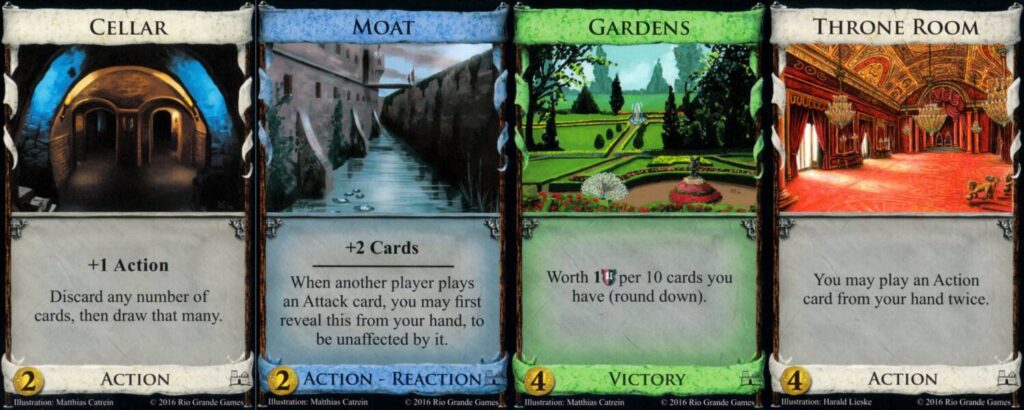
Assess the cards available in the market: what +Actions, +Buys, +Cards are there and how might they work together? Even if you aren’t intending to build an Engine deck, being aware of the chaining potential on offer might give you an idea of what your opponent(s) might do and an indication of the pace of the game. This in turn might help you decide if it’s worth buying Attack cards or not.
Mid-game
At some point your deck will hopefully start behaving in a way that you planned. At this point you might be thinking about purchasing Victory cards – ‘greening’ your deck. Knowing when to make this switch is the key to success. As most Victory cards are terminal cards, make the switch too early and you’ll gum your deck up with cards that are functionally useless and take up space.
There’s no simple rule for when to decide to make the switch. I personally tend to let the first opportunity to purchase a Province pass me by and keep my focus on buying what I feel my deck needs, feeling that I’ll be better placed the next time the opportunity comes along. But it’s not a hard and fast rule and depends on whether I can buy multiple cheaper cards instead and how fast the game is playing. Some people think that you should never pass up an opportunity to buy a Province if you can, whilst others feel you shouldn’t start buying Provinces until you can also buy another Victory card at the same time.
With Engine-type decks it can be very tempting to green too early, particularly if other players start buying up Victory cards. But be careful – a good Engine often takes a while to kick into gear but it’s worth the wait if you don’t sabotage it by pre-greening.
End-game
Whilst your deck is working smoothly in the mid-game, by the time the game is over you should have ruined it with Victory cards. You want it to get across the finish line and then collapse. Be aware that buying Provinces tends to speed up exponentially. Once the Province deck is half empty you’re probably closer to the end than you realise.

At this point buying Action cards is often pointless. Consider how many more turns the game might have before it’s over and therefore how many more turns (and goes through your deck) you might have. Will you see that Action or Treasure card before the game is over? Is it worth buying if you’re only going to see it once? Whilst you probably don’t want Estates or Duchies during the rest of the game, in the final couple of turns loading up on them if you can’t afford another Province is a good way of trying to inch ahead of an opponent who’s level with you.
Opening Moves
The opening moves of Dominion are some of the most well studied of any game that isn’t Chess or Go. Because turns in Dominion are based on the 5 cards you draw and your starting deck consists of 3 Estates and 7 Coppers, for your first two turns you’ll either have 3 and 4 Coppers or 2 and 5 Coppers.
3/4 Copper start
The wisdom of most Dominion players suggests that the best thing to do with 3 Coppers at the start is normally to buy a Silver, regardless of your overall strategy. With the 4 Coppers you can then buy whatever suits your plan best, another Silver or an Action card.
2/5 Copper start
With the less frequent 2/5 Copper start you’re normally best off buying a strong Action card with the 5 Coppers and, assuming there is one, a cheap Action card with the 2 Coppers.
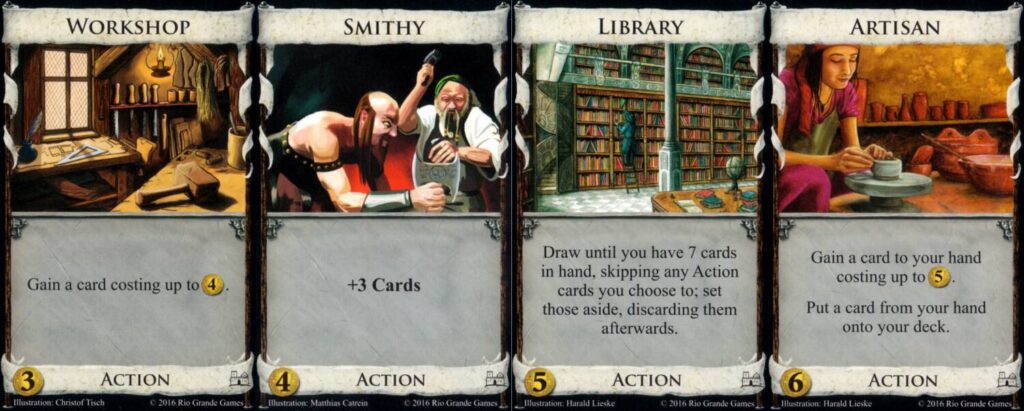
When buying cards on your first and/or second turns, be careful about the type of cards you’re buying. You’ll be seeing them on your third, fourth or possibly fifth turn and the chances are they’ll be working with only Coppers and/or Estates. Make sure they can do something useful themselves – an extra Buy at this point probably isn’t that helpful in most situations, whilst a cantrip that just draws an Estate is a waste. Similarly, drawing 2 terminal cards in your third or fourth hand means that one of those is a dead card. Buying cards in your opening two turns that aren’t exactly aligned with your overall gameplan is often better than loading your fragile early deck with cards that result in duff turns on your second cycle through your deck.
Tending the Pot
Your deck is a pot that you’ll put things into and take things out of over the course of the game. You know everything in the pot at the start of the game and you know everything that you’ve put into the pot.
Try to remember what has gone into and been taken out of the pot, from deck to hand and then to discard or trash. The best Dominion players are in tune with their decks – they know what they’ve seen between shuffles and therefore what they might draw. Knowing that there are still a couple more Golds or powerful Action cards left in a small draw pile can change how you play your hand. Sifters are useful for this but even without these, staying aware of what’s passing through your fingers is a sure-fire way to up your Dominion game.
Taken to an extreme you can even card count, keeping a mental tally of everything in your deck between shuffles. It’s tricky, particularly in the late stages of the game if you’ve not been trashing regularly but it’s possible.
Your opponents
Dominion is not multiplayer solitaire. Every expansion released contains Attack cards and some can be incredibly frustrating. We’ve already discussed the decision of whether to attack your opponents or not but there’s more to playing with other people than just Attacks.
You can, of course, set up the Kingdom cards so that there aren’t any Attacks, but even then keeping an eye on what your opponent(s) are up to is important. This is especially key when you or your opponent(s) are building a duration-style deck. The first time someone catches you off guard by rushing an ending will drive that lesson home.
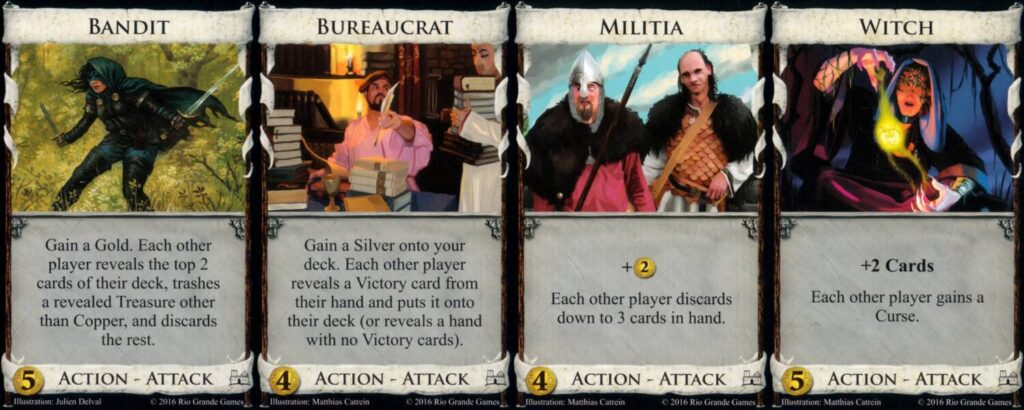
If you see someone trying to empty 3 Kingdom card piles, try not to help them by also buying those cards. And if you’re trying to rush an early ending, see what your opponents are buying and go for those cards, as they might not have spotted your intentions yet and will inadvertently help you out. Similarly, if someone looks like they’re trying to maximise their points with a slog deck, try to force an earlier ending to prevent them from gaining too many more points.
Paying attention to your opponents is also useful if you need to pivot. A common criticism of Dominion is that all the game happens before the first turn is taken, as players come up with their strategies and then just play them out. And there’s a grain of truth in this – you should have a strategy before your first turn based on what you want to do with the Kingdom cards available. But be prepared to pivot and adapt. Monitor your deck and consider what you might add to enhance or realign its performance, and monitor your opponents and see what you might need to do in response to their actions.
Practice
As with anything, getting good at Dominion takes practice. If you don’t have a willing opponent close at hand, look to playing digitally. Happily, there are a couple of good digital options available.

Dominion Online is a browser-based version of Dominion run by ShuffleIt where you can play against others online or against a bot. To access the base cards requires a free account, to access any of the expansions requires a monthly subscription of between $2 and $5. It’s a good version of Dominion and remarkably cheap if you just want to dip in and out of it for a month here or there, although the bot could be better.
Dominion League is a free online tournament that uses Dominion Online. Tournaments are round robins that last 6 weeks and you can advance up the league tiers to face off against more skilled opponents. It’s hosted on the Dominion Discord, which is also worth visiting for thoughts on everything Dominion.
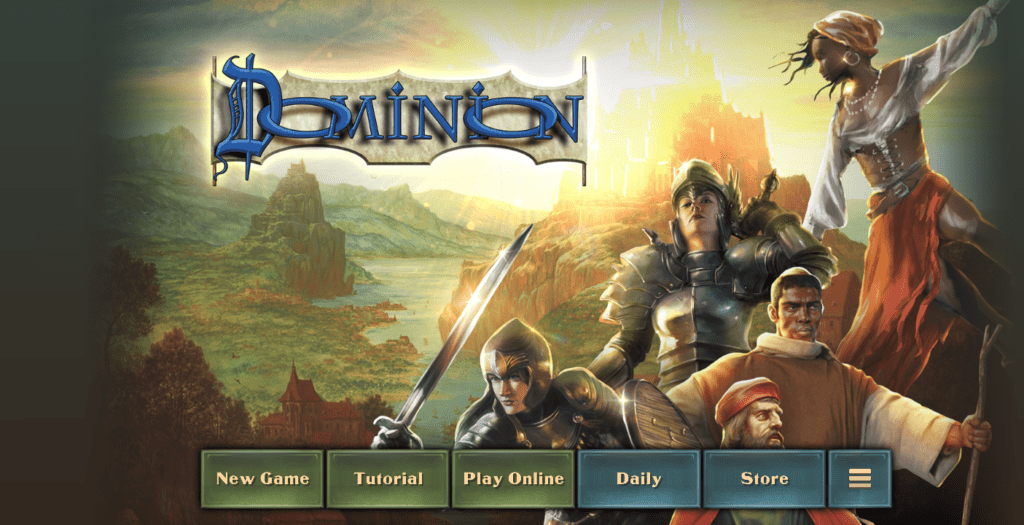
More recently an app version of Dominion has been released, available on iOS, Android and Steam from Temple Gates Games. It’s a good implementation and the daily challenges are fun to explore. The base game is free but you’re looking at $5 to over $10 per expansion if you want to explore all that Dominion has to offer. Good value compared to buying the physical expansions, but relatively pricey for app purchases.
Read Up
Dominion is a deep game, with so many approaches to explore and discover, even within the base game. This guide is a brief overview, but it can’t even begin to approach all the many strategies there are in the game. Below are some other sources of Dominion strategy that you might find useful:
For other brief written overview guides see:
- I Slay the Dragon’s Stacking the Deck – A Dominion strategy guide in 6 parts
- The Thoughtful Gamer’s 10 Strategy Tips for Dominion
- Jordan Marshall’s The 5 (and 10) Minute Dominion Strategy Guide
For videos check out:
- Hardy House Games’ How to Win Dominion – Early Game and Mid/Late Game
- WanderingWinder’s Dominion Strategy Basics Video Series
- Dominion Cards’ Card-by-Card Strategy Videos
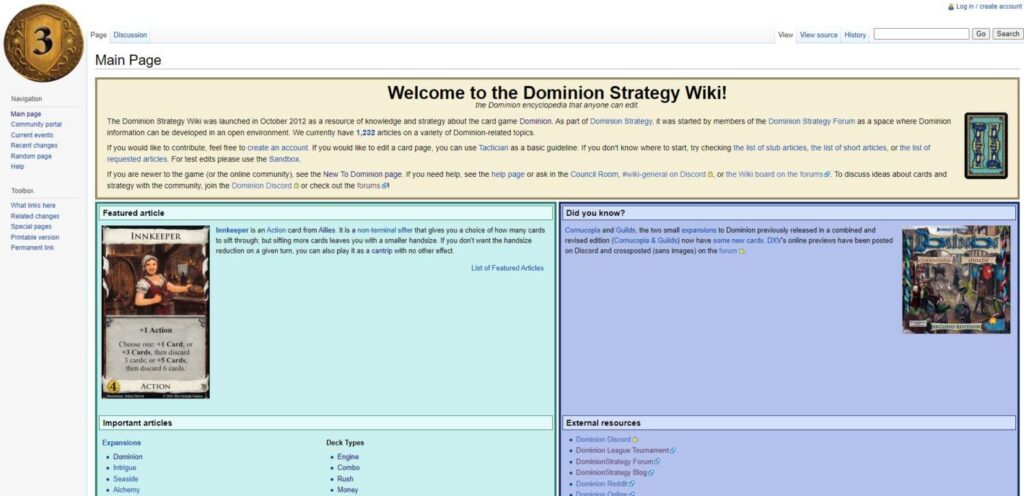
For an extensive dive into everything Dominion then look no further than the Dominion Strategy Wiki, which has over 1,200 articles about Dominion, including pages for each expansion and even pages for every card in the game (most of which include thoughts on strategy). There are also pages on deck types, card rankings, a ‘new to Dominion’ page and so much more. The Wiki started as a blog and forum called Dominion Strategy which also has articles on strategy, as well as interviews with top players and with Dominion designer Donald X. Vaccarino.
Read around. You’ll soon see that people don’t always agree on ideal strategies so discover what they recommend, try things out yourself and see what works for you. And let us know in the comments if you find something we’ve missed or disagree with anything we recommend.
Happy shuffling!













